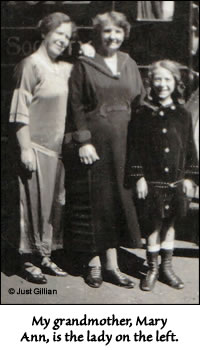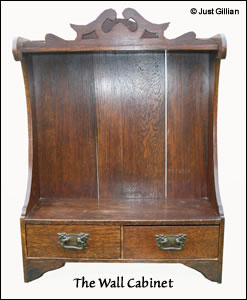One of my mother’s most treasured possessions was a small wooden wall cabinet which her father, John, had made for her mother, Mary Ann. My grandmother was extremely proud of it and used it for storing her little private oddments.

In her turn, my mother kept her own private bits and pieces in it and, as children, my siblings and I were forbidden to touch it. Even years later, when it was necessary to clear the cabinet after my mother’s death, I found myself looking guiltily over my shoulder as I did so.
My grandparents were not at all well off, and with eight children to clothe and feed, there was nothing left over for luxury items in the home. Shoes and larger items of clothing were usually bought by means of the Scottish menage system, whereby a group of women would make a payment for an agreed number of weeks and take it in turns to claim the weekly pool.
When my uncles were old enough, they would help out at local farms before and after school for payment in milk and eggs, and in addition, my grandfather would often receive a rabbit or hare as thanks for doing a neighbour a favour, such as cutting his hair. While my mother grew to hate the taste of the jugged hare, she always acknowledged that she was better fed than many in the village.
Given how little they had, I can well imagine how delighted my grandmother must have been to receive the gift of the little cabinet which was both personal and rather impractical.
My grandfather had emigrated to Glasgow from Ireland as a 14 year old, thinking he could make his living there by Irish dancing. Of course, it had not taken long for him to realise that this was an unrealistic idea and he had soon joined a firm manufacturing furniture where he learned the trade of chairmaking. Some time after 1901, he moved to a workshop in Menstrie, Clackmannanshire, and I am guessing that this is where he must have met my grandmother who was a French polisher at the time of their marriage in 1908.

Curious about where my grandfather would have made the cabinet, I tried to find more details about the Menstrie workshop. From my mother, I knew that he had worked at The Charrier in Menstrie and had always assumed this was a local word for chairmaker. But, after searching without success for photographs or more information, I finally learned from the staff at Alloa Library that The Charrier had in fact been The British Charrier Wood Carving Co. Ltd., which had been established in Menstrie in 1899 after the owner of the local distillery had purchased the French patents for the machinery. Named after the Frenchman who had invented the machinery for producing high quality carving, it provided about one hundred jobs initially – a substantial figure for a village with a population of little over a thousand, especially as the woollen industry was in decline by this time leaving the distillery as the only other major place of employment in the area. According to John Adamson in his book ‘Menstrie A People’s History’, the introduction of these machines transformed the building and architectural industries which, until then, had had to rely on hand carving or plaster moulding.
My grandmother, Mary Ann, died when my mother was just 15, and so I know her only through my mother’s stories of her childhood, two or three fuzzy photos and a letter my grandmother wrote to her children from hospital shortly before her death, in the days when hospital visiting regulations were very strict. But it is clear that she was a remarkable woman and I treasure the little wooden cabinet of which she was so proud.
Just Gillian
© Just Gillian 2009